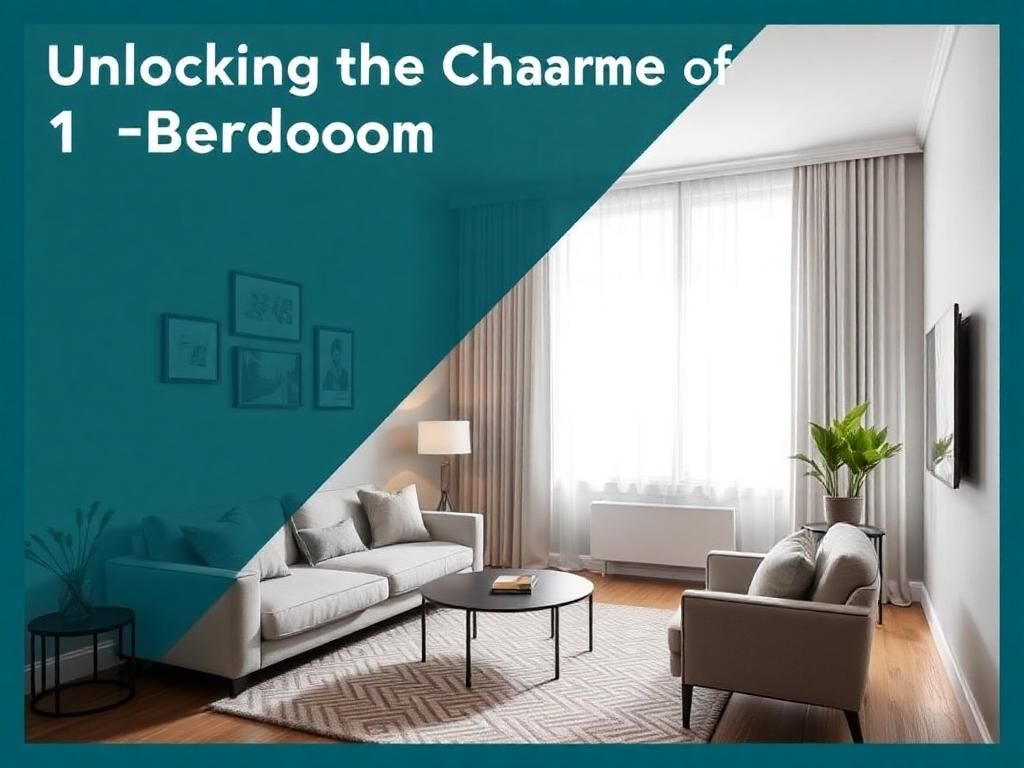A 1-bedroom apartment is generally defined as a self-contained living space that features a separate bedroom, bathroom, and common areas such as a kitchen and living room. These apartments are particularly popular in urban settings, often appealing to young professionals, couples, and even retirees seeking simplicity and affordability. Understanding the ins and outs of living in, finding, and maximizing a 1-bedroom apartment is essential for anyone considering this option, as it opens doors to various lifestyle choices, location advantages, and financial opportunities.
Advantages of Living in a 1-Bedroom Apartment
Affordability
One of the most significant advantages of a 1-bedroom apartment is its affordability. Typically, rent for these units is lower than larger apartments or homes, making them accessible for a broader range of renters. Additionally, utility costs associated with heating, cooling, and electricity are generally lower, easing the overall monthly budget.
Maintenance and Upkeep
Another perk of living in a 1-bedroom apartment is the reduced maintenance and upkeep. With less square footage, cleaning becomes a simpler, faster task. Moreover, if you’re in a condominium or co-op, you’ll likely encounter lower maintenance fees compared to larger properties, allowing you to allocate funds elsewhere.
Ideal for Certain Lifestyles
A 1-bedroom apartment is often the perfect choice for singles, couples, or even remote workers. It provides just the right amount of space for a comfortable yet minimalistic lifestyle. Professionals can also benefit from the centralized location in bustling urban environments that many 1-bedroom apartments offer, making commutes easier and saving time.
Greater Privacy
Living alone in a 1-bedroom apartment provides a level of privacy that is hard to find in shared living situations. Having your own space means fewer disturbances and personal freedom to unwind in your environment without noisy roommates or family members.
Disadvantages of Living in a 1-Bedroom Apartment
Limited Space
While 1-bedroom apartments have various benefits, there are also disadvantages. One key limitation is the restricted space. For families or individuals with many belongings, storage becomes a challenge. Living in a small area can lead to cramped conditions, impacting comfort levels and overall quality of life.
Resale Value and Investment
Another consideration is the resale value. Although 1-bedroom apartments can be great for renters, their resale value often lags behind larger units due to market demand and buyer preferences. Market fluctuations can significantly affect the value proposition, making it critical for investors to evaluate the potential risks involved.
Community Amenities
Tenants of a 1-bedroom apartment may find that they often have limited access to shared amenities. Many larger apartment buildings offer facilities such as pools, gyms, and community rooms that are more challenging to locate in a smaller property, which could impact lifestyle decisions for individuals looking for social experiences.
Choosing the Right 1-Bedroom Apartment
Location Considerations
When searching for the right 1-bedroom apartment, location is key. Look for proximity to your workplace, local public transport, and essential amenities like grocery stores, parks, and medical facilities. Additionally, consider the safety of the neighborhood and its overall vibe to ensure it aligns with your lifestyle.
Apartment Features to Look For
Evaluate the layout and floor plan options when choosing a 1-bedroom apartment. Think about in-unit amenities such as a washer/dryer, kitchen appliances, and outdoor space like a balcony. Rooms should be measured correctly to ensure your furniture fits comfortably without overcrowding.
Budgeting for a 1-Bedroom Apartment
Finding a 1-bedroom apartment that fits within your budget is fundamental. Rental prices vary significantly based on location, size, and amenities. Besides rent, remember to account for additional expenses like utilities, parking, and possible maintenance fees to avoid surprises down the road.
Decorating and Maximizing Space in a 1-Bedroom Apartment
Space-Saving Furniture Solutions
To make the most of your 1-bedroom apartment, consider investing in space-saving furniture. Options like multi-functional sofas that convert into beds, wall-mounted shelves, and organizers can help you manage space more effectively. These solutions maximize functionality without sacrificing style, allowing you to keep your apartment organized and aesthetically pleasing.
Color and Design Tips
Design plays a significant role in how spacious your apartment feels. Opt for light colors when painting walls or choosing furniture. Light hues can create an illusion of space, while mirrors can enhance light and depth within a room, making it feel larger and more open.
Creative Storage Ideas
Utilizing vertical space effectively is crucial in a 1-bedroom apartment. Consider hidden storage options like beds with drawers or ottomans that double as storage units. These strategies can help you keep your living areas clutter-free, making your home feel open and inviting.
The 1-Bedroom Apartment Rental Process
Finding a 1-Bedroom Apartment
In your search for a 1-bedroom apartment, utilize online platforms and real estate websites to explore options that suit your criteria. Additionally, consider working with a real estate agent who can provide valuable insights and assistance in navigating the market.
Touring and Assessing Properties
During your apartment viewings, be prepared with questions to ask the landlord. Evaluate the condition of the apartment, checking for signs of wear and tear, plumbing, appliances, and any other property features critical to your living experience.
Application and Lease Signing
Understanding lease terms and documentation is an essential part of the application process. Be ready to provide required documentation such as proof of income and undergo background checks, which can facilitate a smoother leasing process and bolster your chances of securing your desired 1-bedroom apartment.
Lifestyle Tips for 1-Bedroom Apartment Residents
Building Community Connections
Connecting with neighbors can enhance your living experience in a 1-bedroom apartment. Attend local events and activities to engage with your community, making it easier to build lasting relationships and feel a greater sense of belonging.
Personalizing Your Space
Never underestimate the power of personalization. Adding decor that reflects your personal style, such as artwork and plants, can transform a 1-bedroom apartment into a warm and welcoming sanctuary. Focus on creating a space that truly feels like home.
Managing Noise and Privacy
Noise can be an issue in any living environment, especially in apartments. Consider soundproofing techniques, like adding area rugs or acoustic panels, to minimize sound transfer. Additionally, set boundaries with guests to maintain your private space and enjoy your home in peace.
| Key Factors | Advantages | Disadvantages |
|---|---|---|
| Affordability | Lower rent and utility costs | N/A |
| Maintenance | Easier upkeep and cleaning | Potential shared maintenance costs |
| Space | Ideal for singles or couples | Limited storage and living space |
| Privacy | Less noise and disturbances | Potential isolation |
| Resale Value | Lower entry cost for investors | Potentially lower resale value than larger units |
| Amenities | Localized communal lifestyle | Limited access to shared facilities |
FAQ Section
1. What is the average rent for a 1-bedroom apartment?
The average rent varies widely depending on location (urban vs. suburban), but generally lies between $1,200 and $2,500 in major cities.
2. How can I make a small 1-bedroom apartment feel bigger?
Utilizing mirrors, light colors, and space-saving furniture can all contribute to making your apartment feel more spacious.
3. Are 1-bedroom apartments good investments?
They can be, but factors such as market demand and location play a crucial role in the investment potential.
4. How do I find a 1-bedroom apartment within my budget?
Using online real estate platforms, networking within your community, and being flexible with location can help find affordable options.
5. What should I look for when touring a 1-bedroom apartment?
Check for overall condition, layout, amenities, and noise levels from surrounding units.
6. How can I personalize my 1-bedroom apartment?
Incorporate your style through art, plants, and favorite decor items to make the space feel like home.
7. Is it possible to negotiate rent for a 1-bedroom apartment?
In some cases, landlords may be open to negotiations, especially if you have good rental history or are willing to sign a longer lease.
8. What are the best ways to manage noise in an apartment?
Use rugs, soundproof curtains, and acoustical panels to absorb sound and maintain privacy.
9. How much space do I need for a comfortable living area in a 1-bedroom apartment?
A living area of at least 200 square feet is generally comfortable for a typical 1-bedroom apartment setup.
10. Can I have pets in a 1-bedroom apartment?
It depends on the building’s pet policy. Be sure to inquire about any restrictions or additional fees related to pet ownership.
By breaking down the pros, cons, and practical aspects of living in a 1-bedroom apartment, this guide aims to provide all the information necessary to make an informed decision about your future home. Whether you’re drawn to the affordability, ease of maintenance, or the ideal lifestyle fit, this type of living space offers unique advantages that can cater to a variety of lifestyles and needs.
For more information on apartment living and interior design, consider checking resources such as Apartment Therapy and Zillow for additional insights and tips.


